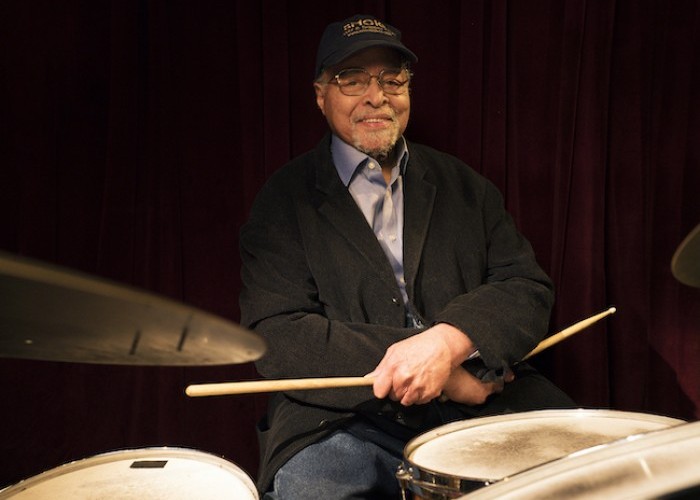Apr 2, 2024 12:59 PM
Saxophonist, Sonic Explorer Casey Benjamin Dies at 45
Casey Benjamin, the alto saxophonist, vocalist, keyboardist and producer who stamped his distinctive sounds on the…

Jimmy Cobb, who turned 90 in January, recently issued a new quartet album, This I Dig Of You.
(Photo: Jimmy Katz)Achieving maximum impact with minimal fuss has been Jimmy Cobb’s M.O. on the drum kit throughout his career, not least on his latest leader album, This I Dig Of You (Smoke Sessions), recorded two weeks after his 90th birthday. It’s another session for which Cobb has retained the services of guitarist Peter Bernstein and bassist John Webber, both frequent bandstand partners since the cusp of the ’90s, and his first with pianist Harold Mabern.
The 10-tune date includes standards, Great American Songbook ballads, less traveled torch songs, Mabern’s modal “Edward Lee” and an original Bernstein blues. It’s a swinging affair, propelled by Cobb’s atomic-clock steady time feel and pristine touch on all his drum-kit components, not least the centered, resonant ride cymbal heard on iconic Miles Davis dates like Kind Of Blue and In Person: Friday Night At The Blackhawk, and classic sessions with Wes Montgomery, Sarah Vaughan, Cannonball Adderley and Dinah Washington.
“I developed it from not having something else,” Cobb remarked of his ride-cymbal concept in June, during a week at the Village Vanguard with the This I Dig Of You band. “Once, on a gig with Dizzy Gillespie, I was playing a coordination thing out of Jim Chapin’s book with figures he’d heard guys play without the bass drum being in 4, as guys had done in the big bands, so that everyone could hear the beat. Dizzy probably was used to hearing his guys play that way, and he came over and put his ear down by the bass drum. I told him, ‘Well, Birks, I don’t have a big 4/4 like that.’ I had to have the beat somewhere, so I concentrated on making it heard on the cymbal. I always liked the way Kenny Clarke played the cymbal—nice and quiet, but definite and killing—and I got some stuff from him.”
Bernstein got his first taste of the Cobb effect circa 1988, when he took the drummer’s Rhythmic Development class at Manhattan’s New School. “Jimmy just called tunes, which we still do,” Bernstein said about the informal sessions. “He didn’t say much about doing this or that. It was the feeling, the lift he provided. I’d never felt such a big or buoyant beat—that smooth ride, the little phrases and the way he resolved them, the accents that pushed the music and moved it forward.”
Cobb continues to impart his “deeds, not words” philosophy to young drummers seeking to unlock the key to his magical ride cymbal. “I tell them the same thing I had to learn,” he said. “Keep a good beat, and don’t work too hard with it—just keep it straight, so everybody likes it.
“I don’t believe in a whole lot of extra motion. I just try to make the guys feel good. That’s all it is. It’s a science, but it’s also not. The part that’s science is to keep the beat going. The art is to make it so we can all enjoy ourselves.” DB

Benjamin possessed a fluid, round sound on the alto saxophone, and he was often most recognizable by the layers of electronic effects that he put onto the instrument.
Apr 2, 2024 12:59 PM
Casey Benjamin, the alto saxophonist, vocalist, keyboardist and producer who stamped his distinctive sounds on the…

“He’s constructing intelligent musical sentences that connect seamlessly, which is the most important part of linear playing,” Charles McPherson said of alto saxophonist Sonny Red.
Feb 27, 2024 1:40 PM
“I might not have felt this way 30 to 40 years ago, but I’ve reached a point where I can hear value in what people…

Albert “Tootie” Heath (1935–2024) followed in the tradition of drummer Kenny Clarke, his idol.
Apr 5, 2024 10:28 AM
Albert “Tootie” Heath, a drummer of impeccable taste and time who was the youngest of three jazz-legend brothers…

“Both of us are quite grounded in the craft, the tradition and the harmonic sense,” Rosenwinkel said of his experience playing with Allen. “Yet I felt we shared something mystical as well.”
Mar 12, 2024 11:42 AM
“There are a few musicians you hear where, as somebody once said, the molecules in the room change. Geri was one of…

Larry Goldings’ versatility keeps him in high demand as a leader, collaborator and sideman.
Feb 21, 2024 10:45 AM
Are you having any fun? Larry Goldings certainly is. Consider just two recent examples:
Scene 1: “If anyone had…